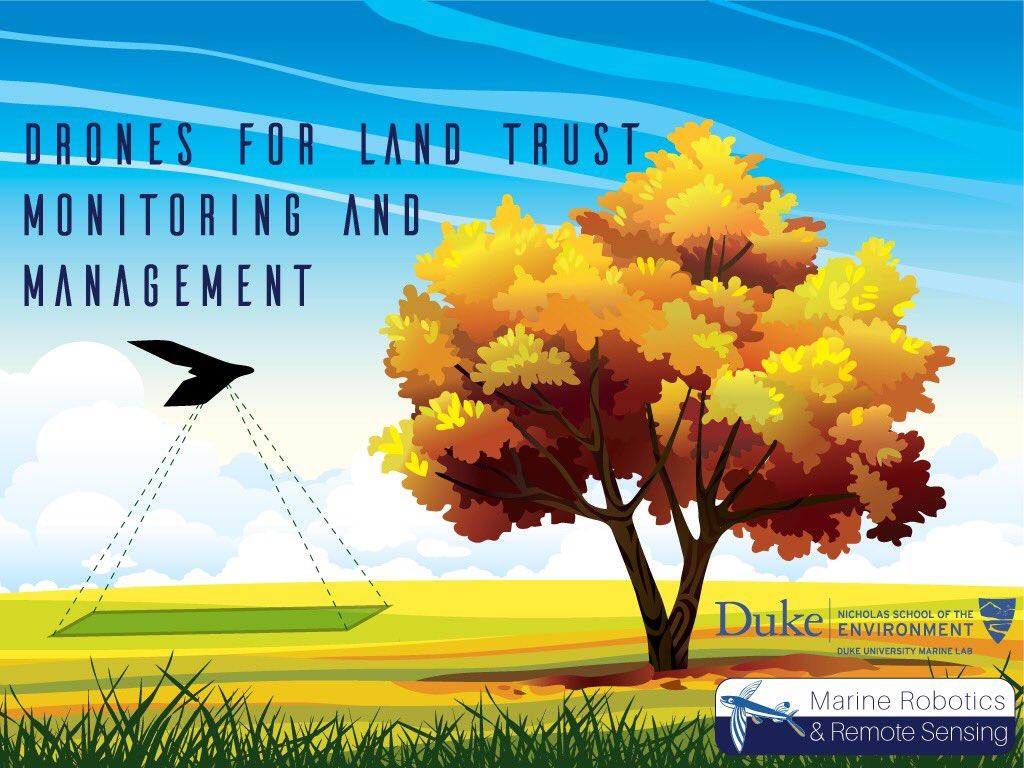Drones can be game-changing tools for conservation and environmental science, but information about how to appropriately adopt and apply these tools can be hard to come by. To address this gap, the Duke Marine Robotics and Remote Sensing Lab and the Nicholas School Executive Education Program are proud to announce a new course: Drones for Land Trust Monitoring and Management.
This 1-month online course will help environmental professionals determine how and when to apply unmanned aerial systems (UAS) technology to their conservation projects, specifically focusing on land trust and stewardship applications. Experts at the Duke University Marine Robotics and Remote Sensing Lab will advise and instruct on integrating this emerging technology into land trust workflows and management programs. Tuition is set at $250 USD
What does the course cover?
How much do drones and their associated support software cost?
Depending on the data products desired, a land trust can begin collecting usable data with UAS for as little as $1,500 – $2,000. Basic mapping products will require a minimum investment of $5,000 – $6,000. Mid-range, purpose-built UAS and advanced mapping products will require $14,000 – $18,000. The most sophisticated UAS and support software/equipment applicable to land trust use costs $25,000 – $30,000. Our course will help holders decide what level of investment is right for their monitoring goal
How much do drones and their associated support software cost?
Depending on the data products desired, a land trust can begin collecting usable data with UAS for as little as $1,500 – $2,000. Basic mapping products will require a minimum investment of $5,000 – $6,000. Mid-range, purpose-built UAS and advanced mapping products will require $14,000 – $18,000. The most sophisticated UAS and support software/equipment applicable to land trust use costs $25,000 – $30,000. Our course will help holders decide what level of investment is right for their monitoring goal
How do I get landowners to agree to drone flights over holdings?
Currently, the FAA (which governs UAS use) does not prohibit UAS flights over private property. However, state and local law may take a different stance, and privacy laws surrounding UAS use are evolving. Public perception and relationships with landowners are also critical for a land trust. This means that getting explicit permission from landowners and neighbors is a best practice regardless of local law. Our course will discuss how to operate UAS in a legally conservative manner and use drones to engage landowners rather than alienate them.
If a land trust lacks personnel, time, expertise, etc., how can drone services be contracted?
The number of UAS consultants and contractors have grown significantly since 2016. The decision to contract UAS work or stay in-house depends on the number of holdings that need to be monitored, the size and location of a holding in question, and the nature of the data product needed. Contracting UAS services can be more expensive that operating in-house, depending on how often UAS are used. There are also specific questions a land trust should ask potential contractors in order to ensure good data quality is generated. These questions and more will be addressed in the course.
What kind of resources are needed to pass the FAA’s commercial drone pilot Part 107 test?
The FAA Part 107 license is required for anyone operating a drone for commercial or research purposes, and is a prerequisite for any land trust that wants to adopt UAS technology. However, the exam is not difficult, and an individual can pass the test by purchasing a single test prep book and dedicating a couple weeks to study. The Part 107 exam is one of the easier aspects of adopting UAS technology.
Does the course tuition cover Part 107 exam test prep, or exam fees?
No, the course does not cover exam test prep or fees. There are many Part 107 test prep resources already available, and we’re focusing on some of the harder decisions regarding UAS operation. However, we will discuss how Part 107 rules influence the way data can be collected with UAS.
How can we minimize impacts to wildlife when using drones?
This is a question we are actively investigating at MaRRS. We’ve found that wildlife reactions vary greatly depending on the species, noise produced by the aircraft, and even the shape of the aircraft. The course will address some of our experiences with wildlife in our survey areas.
Find out more
The online course begins on 1st March, 2018. To learn more about this course and enrol, visit the course website.







Add the first post in this thread.